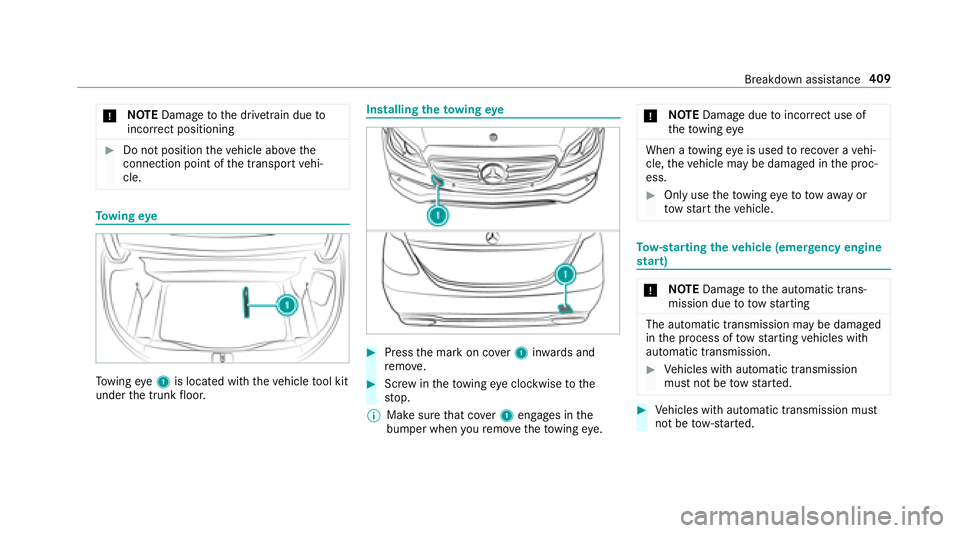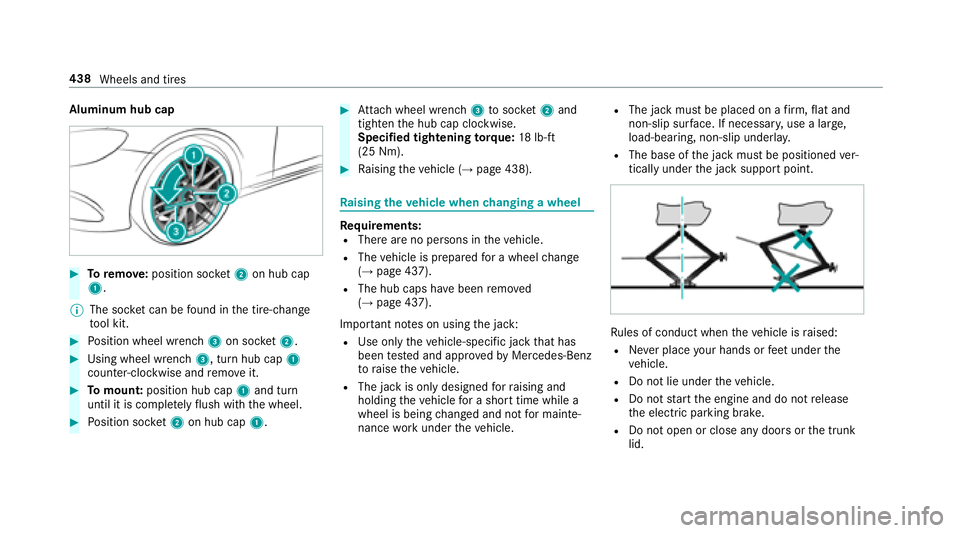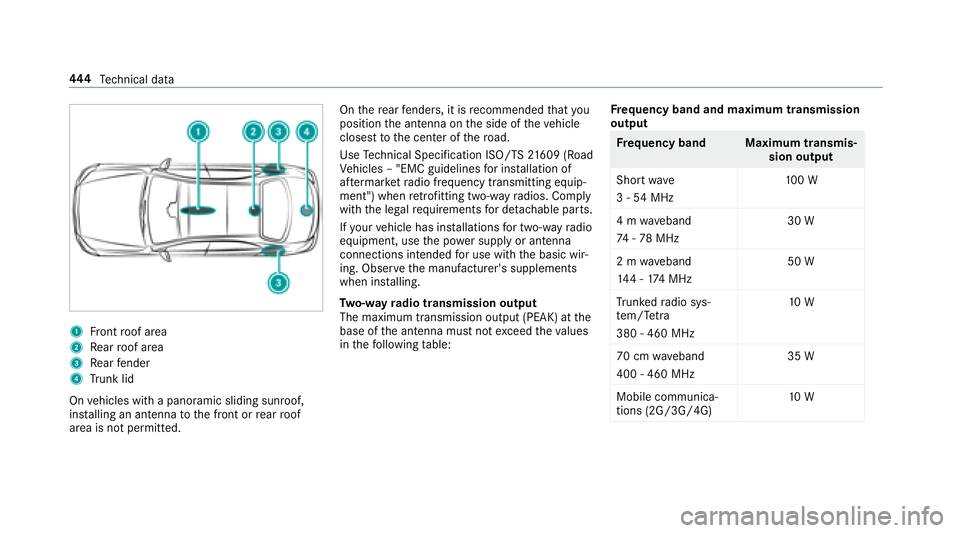Page 411 of 562

*NO
TEDama getothe driv etra in due to
incor rect positioning
#Do not position theve hicle abo vethe
connection point of the transport vehi‐
cle.
To wing eye
Towing eye1 is located with theve hicle tool kit
under the trunk floor.
Installing theto wing eye
#Press the mark on co ver1 inwa rds and
re mo ve.
#Scr ew intheto wing eyeclockwise tothe
st op.
% Make sure that co ver1 engages in the
bumper when youre mo vetheto wing eye. *
NO
TEDama gedue toincor rect use of
th eto wing eye
When a towing eye is used toreco ver a vehi‐
cle, theve hicle may be damaged in the proc‐
ess.
#Only use theto wing eyeto to waw ay or
to w start theve hicle.
To w- starting theve hicle (eme rgency engine
st art)
* NO
TEDama getothe automatic trans‐
mission due to towstarting
The automatic transmission may be damaged
in the process of tow starting vehicles with
automatic transmission.
#Ve hicles with automatic transmission
must not be tow star ted.
#Ve hicles with automatic transmission must
not be tow- star ted.
Breakdown assis tance 409
Page 412 of 562

Electrical fuses
Notes on electrical fuses
&
WARNING Risk of accident and injury
due to ov erloaded lines
If yo u man ipulate orbridg e afaulty fuse or if
yo ure place it with a fuse with a higher
amperage, the electric line could be overloa‐
ded.
This could result in a fire .
#Alw aysre place faulty fuses with speci‐
fi ed new fuses conta iningthe cor rect
amperage.
* NO
TEDama gecaused byincor rect fuses
Incor rect fuses may cause damage toelectri‐
cal components or sy stems.
#Only use Mercedes-Benz appr oved
fuses with the cor rect fuse rating.
Blown fuses must bereplaced with fuses of the
same rating, which you can recognize bythe
color and fuse rating. The fuse ratings are li sted in
the fuse assignment diagram. The fuse assign‐
ment diagram is in theve hicle document wallet.
* NO
TEDama geor malfunctions caused
by moisture
Moisture may cause dama getothe electrical
sy stem or cause it tomalfunction.
#When the fuse box is open, make sure
th at no moisture can enter the fuse
box.
#When closing the fuse box, make sure
th at the seal of the lid is positioned cor‐
re ctly on the fuse box.
Ifth e newly inser ted fuse also blo ws, ha vethe
cause traced and rectified at a qualified special‐
ist workshop, e.g. an authorized Mercedes-Benz
Center.
Ensure thefo llowing before replacing a fuse:
RThe vehicle is secured against rolling away.
RAll electrical consumers are switched off.
RThe ignition is switched off. The electrical fuses are located in
various fuse
bo xes:
RFu se box in the engine compartment on the
driver's side (→page 410)
RFu se box on the driver's side of the dash‐
board (→page 412)
RFu se box in the front-passen gerfo ot we ll
(→page 412)
RFu se box in the trunk on theright-hand side
of theve hicle, when vie wed in the direction
of tra vel (
→page 412)
Fu se box in the engine compa rtment
Requ irements:RObser vethe no tes on electrical fuses
(→page 410).
Ha ve thefo llowing readily available:
RA dry clo th
RA screwdriver
410
Breakdown assis tance
Page 414 of 562
#Insertthe lid into the brac ket at there ar of
th e fuse box.
#Fo ld down lid of the fuse box and tighten
scr ews4.
#Insert co ver2 on bo thsides and engage
re taining clips 1.
#Closethe hood.
Dashboard fuse box
The fuse box is on the side of the dashboard
under a co ver.
#Open co ver1 inthe direction of the ar row
and remo veit.
Fuse box in the front-passenger foot we ll
Requirement:RObser vethe no tes on electrical fuses
(→page 410).
#Open cover1 inthe direction of the ar row
and remo veit.
Fuse box in the trunk
Re quirement:RObser vethe no tes on electrical fuses
(→page 410).
#Fo ld co ver1 down in the direction of the
ar row .
412
Breakdown assis tance
Page 438 of 562

Thewear patte rns on the front and rear wheels
dif fer:
RFr ont wheels wear more on the shoulder of
th e tire.
RRe ar wheels wear more in the center of the
tire.
On vehicles that ha vethe same size front and
re ar wheels, inter change the wheels according
to the inter vals in the tire manufacturer's war‐
ra nty book in your vehicle documents. If this is
not available, inter change the tires every
3000 to6000 miles (5000 to10000 km),
depending on thewe ar. Ensure that the direction
of rotation is maintained.
It is impe rative toobser vethe instructions and
saf etyno tes on "Wheel change" when doing so.
Note s onstoring wheels
RAf terre moving wheels, store them in a cool,
dry and preferably dark place.
RPr otect the tires from conta ct withoil, grease
or fuel.
Overview of the tire-chan getool kit
Apart from some countr y-specific variants, vehi‐
cles are not equipped with a tire-change tool kit.
Fo r more information on which tire-changing
to ols are required and appr oved for per form ing a
wheel change on your vehicle, consult a qualified
specialist workshop.
Re quired tire-change tools may include, for
ex ample:
RJack
Rch ock
RLu g wrench
RCentering pin
The tire-change tool kit is located under the
trunk floor.
1Ra tchet
2Centering pin
3Jack ing support
4Jack
5Lu g wrench
6Fo lding chock
436
Wheels and tires
Page 440 of 562

Aluminum hub cap
#Toremo ve:position soc ket2 on hub cap
1.
% The soc ket can be found inthe tire-change
to ol kit.
#Po sition wheel wrench 3on soc ket2.
#Using wheel wrench 3, turn hub cap1
counter-clo ckwise and remo veit.
#To mount: position hub cap 1and turn
until it is compl etely flush withth e wheel.
#Po sition soc ket2 on hub cap 1.
#Attach wheel wrench 3tosoc ket2 and
tighten the hub cap clockwise.
Specified tightening torq ue: 18lb-ft
(25 Nm).
#Ra ising theve hicle (→page 438).
Ra ising theve hicle when changing a wheel
Re quirements:RThere are no persons in theve hicle.
RThe vehicle is prepared for a wheel change
(→page 437).
RThe hub caps ha vebeen remo ved
(→page 437).
Impor tant no tes on using the jack:
RUse only theve hicle-specific jack that has
been tested and appr oved byMercedes-Benz
to raise theve hicle.
RThe jack is only designed forra ising and
holding theve hicle for a short time while a
wheel is being changed and not for mainte‐
nance workunder theve hicle.
RThe jack must be placed on a firm ,fl at and
non-slip sur face. If necessar y,use a lar ge,
load-bearing, non-slip underla y.
RThe base ofthe jack must be positioned ver‐
tically under the jack support point.
Ru les of conduct when theve hicle is raised:
RNe ver place your hands or feet under the
ve hicle.
RDo not lie under theve hicle.
RDo not start the engine and do not release
th e electric parking brake.
RDo not open or close any doors or the trunk
lid.
438 Wheels and tires
Page 446 of 562

1Front roof area
2Re ar roof area
3Re ar fender
4Trunk lid
On vehicles with a panoramic sliding sunroof,
ins talling an antenna tothe front or rear roof
area is not permitted. On
there ar fende rs, it is recommended that you
position the antenna on the side of theve hicle
closest tothe center of thero ad.
Use Tech nical Specification ISO/TS 21609 (Road
Ve hicles – "EMC guidelines for ins tallation of
af te rm arke tra dio frequency transmitting equip‐
ment") when retrofitting two-w ayradios. Comply
with the legal requ irements for de tachable parts.
If yo ur vehicle has ins tallations for two-w ayradio
equipment, use the po wer supply or antenna
connections intended for use with the basic wir‐
ing. Obser vethe manufacturer's supplements
when ins talling.
Tw o-w ayradio transmission output
The maximum transmission output (PEAK) at the
base of the antenna must not exceed theva lues
in thefo llowing table: Fr
equency band and maximum transmission
output
Fr equency band Maximum transmis‐
sion output
Sho rtwa ve
3 - 54 MHz 10
0 W
4 m waveband
74 -78 MHz 30 W
2 m waveband
14 4 - 174 MHz 50 W
Tr unked radio sys‐
te m/T etra
380 - 460 MHz 10
W
70 cm waveband
400 - 460 MHz 35 W
Mobile communica‐
tions (2G/3G/4G) 10
W
444
Tech nical da ta
Page 447 of 562
Thefollowing can be used in theve hicle without
re strictions:
RRF transmitters wi tha maximum transmis‐
sion output of up to100 mW
RRF transmitters with transmitter frequencies
inthe 380 - 410 MHz frequency band and a
maximum transmission output of up to2 W
(trunked radio sy stem/T etra )
RMobile phones (2G/3G/4G)
There are no restrictions when positioning the
antenna on the outside of theve hicle for some
frequency bands.
This applies tothefo llowing frequency bands:
RTrunked radio sy stem/T etra
R70 cm waveband
R2G/3G/4G
Ve hicle identification plate, VIN and engine
number overview
Ve hicle identification plate
Vehicle identification plate (USA only)
1Perm issible grossmass
2Pe rm issible front axle load
3Perm issible rear axle load
4Pa int code
5VIN (vehicle identification number)
Tech nical da ta44
5
Page 500 of 562
Displaymessages
Possible causes/consequences and MSolutions
N
*The trunk lid is open.
&
WARNING Risk ofexhaust gas poisoning
Combustion engines emit poisonous exhaust gases such as carbon monoxide. Exhaust gases can enter the
ve hicle interior if the trunk lid is open when the engine is running, especially if theve hicle is in motion.
#Alw ays switch off the engine before opening the trunk lid.
#Ne ver drive with the trunk lid open.
#Close the trunk lid.
_
�5�H�D�U �/�H�I�W �%�D�F�N�U�H�V�W �1�R�W
�/�D�W�F�K�H�G (examp le) *T
he cor responding seat backrest of there ar bench seat is not engaged.
#Foldthe cor responding seat backrest back until it engages.
¥
�&�K�H�F�N �:�D�V�K�H�U �)�O�X�L�G *T
hewasher fluid leve l in thewa sher fluid reser voir has dropped below the minimum.
#Ad dwa sher fluid .
498
Display messages and warning/indicator lamps